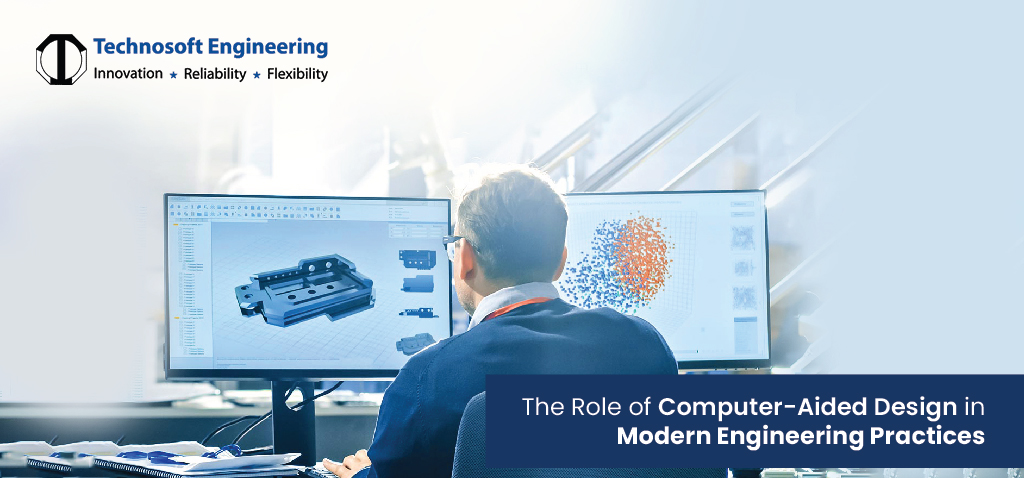
What is Finite Element Analysis (FEA): Understanding the Technology, Software and Applications
Introduction The modern engineering field relies heavily on the use of finite element analysis (FEA), which is a sophisticated method for analyzing and predicting complex structures. Today we will unfold the delicate details of FEA technology, software tools and applications in various industries. We will also understand the intricacies of FEA & CFD and its […]
Read More
The Role of Computer-Aided Design in Modern Engineering Practices
Modern engineering practices are incomplete without the input of computer-aided design (CAD). This technology has transformed the approach of engineers and designers towards product and structure development. With the help of CAD, our expert engineers can develop more detailed and efficient designs for you that will lead to superior outcomes and innovation in many sectors. […]
Read More
How do you effectively leverage FEA and CFD within your CAD/CAM projects to optimize design and performance?
Key Takeaways In engineering design and analysis, Finite Element Analysis (FEA) and Computational Fluid Dynamics (CFD) are critical tools that enable engineers to optimize design, improve performance, and gain speed in product development. This exhaustive guide discusses the intricacies involved in leveraging FEA and CFD within CAD/CAM projects, outlining their capabilities, advantages, and challenges for […]
Read More
How does the Internet of Things ecosystem adapt to cloud computing ?
Introduction The internet of things (IoT) has developed in a fast way, linking billions of devices that are capable of communicating and sharing data. With these devices continuing to spread, this has led to the need for efficient data management, processing and storage solutions being on the rise. Cloud computing comes into play in such […]
Read More
What Is Engineering Documentation ?
Table of Contents Key Electrical Documentation Types Used at Technosoft Engineering What Is the Importance of Technical Documentation in Engineering? Engineering documentation is an essential component of collaboration on engineering projects. For example, when designing a bridge, multiple disciplines need to work together, such as civil engineers, structural engineers, and architects. Consider the fact that […]
Read More
What is Computer Aided Engineering (CAE)?
Table of Contents What is Computer Aided Engineering (CAE)? How does Computer Aided Engineering (CAE) work? Advantages of Computer Aided Engineering (CAE) Disadvantages of Computer Aided Engineering (CAE) Who Uses Computer Aided Engineering? What Industries Use CAE? for Industrial Applications? What Does A CAE Engineer Do? How Has Computer Aided Design Helped Engineers? Key Takeaways […]
Read More
What Is The Difference Between M&E – Mechanical And Electrical Engineering Service Contracts ?
In the field of mechanical design and engineering services, particularly in the context of contracts, it is highly important to know the differences between mechanical and electrical engineering. Both fields play integral roles in various industries, each with their own areas of expertise and applications. Today we will introduce a fundamental difference between mechanical and […]
Read More
Cloud computing and IoT: How Do They Work?
Table of Contents What is IoT ? What is cloud computing? What are some advantages offered by Cloud Computing? What does IaaS PaaS SaaS CaaS stand for? What Is the Connection between IoT and Cloud Computing? Why is Cloud Computing Important for Successful IoT? Technosoft IoT & Cloud Services Case Study: Wireless Smart Home Lighting […]
Read More
What Is a Steam Turbine, What Are Its Types and How Does It Work?
In the world of power generation, few inventions have been as pivotal as the Steam Turbine. These machines are the workhorses behind many industrial and power plants, converting the energy stored in steam into mechanical work. Let’s delve into the depths of Steam Turbines: their types, functions, and the captivating science behind their operation. What […]
Read More
Hierarchical state machine in embedded systems
Embedded system design revolves around efficiency and precision, demanding sophisticated structures like Hierarchical state machines (HSM) to manage complexity while ensuring optimal functionality. At its core, Hierarchical State Machines is a powerful model used to organize complex systems by breaking them into manageable states and transitions. In Embedded System, HSMs provide a clear visualization of […]
Read More
What Is The History Of Water Turbine Technology? A Blog by Technosoft Engineering
Water Turbines have been a pivotal part of our journey harnessing nature’s power for centuries. These incredible machines, also known as Hydropower Turbines, have a fascinating history deeply intertwined with human innovation and the quest for renewable energy sources. Let’s dive into the captivating tale of how water turbine technology came to be and evolved […]
Read More
What are the different Types of Turbines and classifications?
Turbines, the mechanical powerhouses driving various industries and generating energy, stand as pivotal components in modern engineering. Harnessing the kinetic energy from various sources, water turbines, steam turbines, gas turbines, and wind turbines play instrumental roles in converting this energy into useful forms like electricity or mechanical power. Turbines operate on the principle of energy […]
Read More
